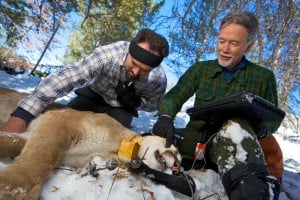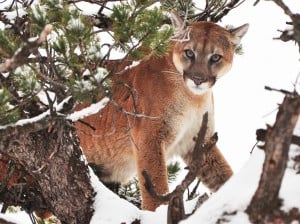--- On Fri, 12/9/11, Wolves, Wolf Facts, Cougars, Cougar Facts, Coyotes, Coyote Facts - Wolves, Cougars, Coyotes Forever <rick.meril@gmail.com> wrote:
| |||||
| Posted: 08 Dec 2011 08:57 PM PST During my career with the Illinois Department of Natural Resources, I used to mock folks who told me they saw a mountain lion or cougar in Southern Illinois.We in the IDNR used to think these people had eyesight problems, smoked illegal leafy plants or got into grandpa's persimmon wine too much.But I do not doubt folks anymore.In November of this year, the Wisconsin Department of Natural Resources put out a press release warning deer hunters to be aware that there were confirmed cougar sightings in central and northern Wisconsin.That's right; a state-issued warning. It's no lie or hoax; you can check online yourself (simply "google" wisconsin cougar sightings 2011).During my 27-year IDNR career, I was aware of three confirmed cougar deaths in Illinois:1. On July 15, 2000, a dead young male cougar was found near railroad tracks in Randolph County.2. On Dec. 4, 2004, a dead cougar was found by hunters near New Boston in Mercer County. Apparently, this cougar had been shot with an arrow and had escaped from the bow hunter before it died. I recall personally speaking via cell phone to the conservation police officer who was on site with the dead animal.3. On April 4, 2008, a young male cougar was shot and killed by Chicago police when it was observed in a residential neighborhood on the city's north side. Earlier that year, a cougar had been confirmed sighted in southern Wisconsin and in several towns north of Chicago; it's believed that that was the cougar shot by the Chicago cops. It made all the Chicago papers and a few national ones.Please note that Nos. 1 and 2 were near the Mississippi River; No. 3 is believed to have traveled some of the "green belt" habitat areas along Interstate 294 and possibly the Des Plaines River watershed. Believe it or not, Cook and Lake counties have a lot of green belt habitat areas.What's rather odd is that I do not recall the IDNR saying one word about these instances. Not any comments or press releases or anything.I guess if the IDNR keeps quiet about it, the public will just forget and the matter will go away.My personal opinion is that the IDNR fears it will create a public minipanic and may cause undue public fear if they said anything about these critters. The last thing needed is a group of buffoons out there with their dogs claiming they are going "mountain lion huntin'."I doubt anyone with the IDNR will go "on record" on this issue.Over the last few years, a small number of cougars have been sighted in Missouri and Iowa; a few have even been killed. Don't believe me; check for yourself. We here in Southern Illinois are blessed with large amounts of wildlife habitat. We have the river corridors along the Mississippi, Ohio, Wabash and Little Wabash rivers, along with numerous smaller steams and waterways. And don't forget Shawnee National Forest.A mountain lion or cougar is an "alpha predator." One of its primary food sources is deer. We have a few of them around here, too.A few years ago, I remember picking up my first road-killed bobcat in White County. It made the front page of the Carmi Times.Since then, I've personally seen four live ones while bow-hunting; many others have also seen bobcats. I wouldn't say we're "lousy" with bobcats, but there are more that a few around.So if you ask me, I believe that one day, someone will either kill a cougar or one will be hit on the road somewhere around here in Southern Illinois. It's simply inevitable.Sadly, it will take a dead specimen to prove that they are around. It won't be an "escaped pet" or a dead one that a trucker picked up in South Dakota and dumped out here for a joke.In all likelihood, it will be a 100-pound-plus male wild cougar which is roaming to find new habitat areas.I personally had never seen a live or dead cougar in Illinois during my IDNR career. If I come across a dead cougar around here, I'm going to keep it and get a full body mount of it.I will allow the IDNR to take DNA and hair samples, but they aren't getting the whole thing.I know that a CPO will probably try to bluff me into giving it up, but I know better. They can't legally force me to turn it over to them.Plus, I know that if I did give it up, it would probably simply "disappear" just like the three dead ones I mentioned earlier in this article.Full disclosure: Dr. Lars Gentry says my eyesight is fine; I will "pee" in a cup to prove I do not smoke that green leafy material; and I don't drink too much of the "homebrew" which Eddie and I make on occasion.• Rich Gurka is a resident of White County and retired as a conservation police officer with the Illinois Department of Natural Resources. | |||||
| Posted: 08 Dec 2011 08:54 PM PST Bozeman scientist's work with cougars, jaguars featured by National Geographic  Big Cat WeekPhoto courtesy of Steve Winter/Panthera Bozeman wildlife biologist Howard Quigley, right, and Luke Hunter, president of the nonprofit Panthera, replace a radio collar on a male cougar tranquilized near Jackson Hole, Wyo. The cat is featured in Sunday night's documentary, "American Cougar," which kicks off National Geographic Wild 's weeklong TV documentary series for Big Cat Week.ÊThe world's big cats are in big trouble.The National Geographic Wild television channel will focus on the lives and plights of lions, tigers, jaguars and other large felines next week during its Big Cats Week.The series kicks off with two documentaries featuring work by Bozeman-based scientist Howard Quigley, one of the top researchers on big cats."They are fascinating," said Quigley, 59, who has spent some 30 years studying cougars, Siberian tigers and jaguars.Through his research, Quigley has sought both a better scientific understanding of how big cats live and better ways to save them from extinction.As National Geographic magazine reports in the current issue, big cats face threats from human population growth, poaching, Chinese black markets, habitat destruction, development and ineffective sanctuaries. Tigers, down to a few thousand animals in the wild, have reached a crisis level.The TV series begins Sunday with "American Cougar," filmed by cinematographer Jeff Hogan over the past year in the Jackson Hole area of Wyoming, where Quigley has been researching the cats. Cougars are extremely secretive. Quigley said sometimes he can't find them, even when a radio collar signal reveals an animal is nearby.Thanks to remote, motion-sensor cameras and dogged work, Quigley said, the filmmaker got "wonderful" video of cougars feeding in the wild, hiding their kills, mating, playing with a stick and raising a kitten."Viewers will see some aspects of cougars nobody has ever seen before," Quigley said. "In the film we tried to really take people into the lives of cougars."The first time I saw it, I felt it was a tremendous privilege to be allowed into the life and behaviors of wild cougars. They generally avoid people."Cougars are "super survivors," Quigley said.In the 1930s, cougars were eliminated in most of the United States — poisoned, baited and killed by bounty hunters, much like their fellow predators, wolves. The cats were more successful in avoiding extermination in the Northern Rockies and rugged parts of the West.Thirty years ago, thanks to Maurice Hornocker's scientific research in Idaho, cougars were reclassified from predators to big game species. Had that not happened, Quigley said, there's a good chance cougars would have been wiped out.Today cougars are probably the "least endangered of the big cats," Quigley said. Though the Florida panther is endangered, cougars are big game species in most Western states, like Montana. They're hunted, but wildlife managers control the hunt to maintain healthy populations. The exceptions are polar opposites: Texas, where cougars can be shot on sight, and California, where voters outlawed hunting of cougars."The cougar is doing quite well and expanding in the Midwest," Quigley said. A big threat to cougars now may be wolves. Since wolves were reintroduced in Yellowstone National Park, there are fewer cougar kittens. From 2004 to 2008, out of the four to six females tracked near Jackson, Wyo., only one litter was produced, Quigley said. It's not yet clear whether wolves directly kill kittens or disrupt cougar females' behavior.Quigley said he hopes research on cougars will translate into better understanding of big cats in other parts of the world. Now with the nonprofit group Panthera, he directs its program to save jaguars. Monday night, the National Geographic channel will broadcast "Hunt for the Shadow Cat." Jaguars "are at a critical time," Quigley said. "Development of Latin America is happening at a rapid pace."Smithsonian magazine reported in its October issue on "The Jaguar Freeway," Panthera's effort to maintain corridors connecting jaguar populations from Mexico to South America, so the cats can interbreed and avoid becoming isolated and vulnerable.Quigley said he hopes the TV documentaries will produce "an elevated level of appreciation of the ecology and natural history of big cats." |
| You are subscribed to email updates from Wolves, Wolf Facts, Cougars, Cougar Facts, Coyotes, Coyote Facts - Wolves, Cougars, Coyotes Forever To stop receiving these emails, you may unsubscribe now. | Email delivery powered by Google |
| Google Inc., 20 West Kinzie, Chicago IL USA 60610 | |







No comments:
Post a Comment